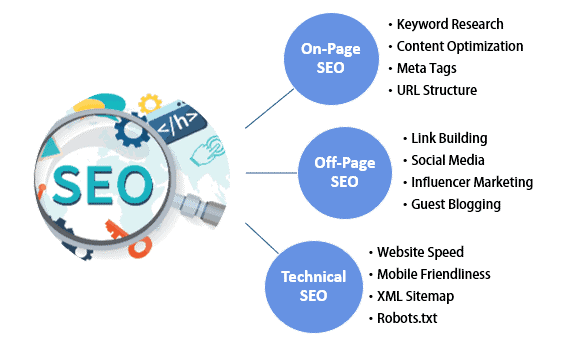This guide is intended to help you in Mastering Search Engine Optimization. You will get the mastery, knowledge and abilities necessary to rank better on search engines and successfully reach your target audience by following this guide, which will walk you through the key ideas, strategies and tools of SEO.
Mastering Search Engine Optimization
This guide is intended to help you thrive in the always changing search Engine Optimization strategies, regardless of your level of experience with SEO.

What is Search Engine Optimization (SEO)
The process of improving a website’s/ online content visibility and search engine ranking is known as search engine optimization. The primary goal of SEO, which aims to increase organic traffic to a website, is to make a website and online content attractive and relevant to search engines.
The Importance of SEO in Digital Marketing
Any digital business that wants to succeed online needs to invest on SEO skills. It offers a long-term, sustainable way to accomplish enhanced visibility, targeted traffic driving, credibility building and long-term growth. By investing in SEO skills, businesses can increase their online visibility, beat off competitors, ensure that their content reaches and engages their target audience.
High-quality content is the backbone of SEO, ensuring your material reaches the right audience. Optimized content boosts your content marketing efforts by increasing the chances of it being shared and linked to.
- Increased Visibility and Traffic
Improving your website’s SEO boosts its position on search engine results pages (SERPs), making it more likely that potential customers will find you. Unlike paid ads, organic traffic is free and sustainable over time.
- Enhanced Credibility and Trust
Websites that appear at the top of search results are often viewed as more credible and authoritative. High rankings increase the chances that users will click on and trust your site.
- Improved User Experience
SEO optimizes your site’s performance, structure, and mobile compatibility, enhancing the overall user experience. Creating valuable and relevant content also improves user satisfaction and engagement.
- Targeted Audience
SEO drives relevant traffic by targeting keywords that potential customers are actively searching for. For businesses with a local presence, local SEO attracts nearby clients looking for specific products or services.
- Trackable Results
Tools like Google Analytics and Search Console help you monitor and measure the success of your SEO efforts. The insights gained from SEO data can guide your business and marketing strategies.
- Cost-Effective Strategy
Unlike paid ads that require ongoing investment, the benefits of SEO can last long after the initial effort. Effective SEO strategies provide a high return on investment through consistent traffic and conversions.
- Building Connections
SEO involves acquiring backlinks from reputable websites, which can lead to partnerships and collaborations. Combining SEO with social media marketing can further enhance audience engagement.
- Adaptability
SEO keeps you informed about algorithm changes, ensuring your website remains competitive and compliant. As technology and consumer behavior evolve, SEO strategies can adapt accordingly.
- Content Marketing Synergy
High-quality content is the backbone of SEO, ensuring your material reaches the right audience. Optimized content boosts your content marketing efforts by increasing the chances of it being shared and linked to.
How to do SEO Marketing for different Industries
SEO is beneficial for digital enterprises who wish to increase their online presence and draw in more organic visitors.
1.Bloggers and Digital Content Creators
- Bloggers: Use SEO to draw in readers and build a dedicated audience.
- Video Creators: Optimize video tags, descriptions and titles to boost visibility on platforms like YouTube.
- Podcasters: Enhance podcast titles and descriptions with SEO to attract more listeners.
2.Media and Publishing Companies
- News Sites: Optimize articles to rank highly for trending topics and current events.
- Magazines and Journals: Use SEO to engage readers with specific interests in various industries or niches.
3.Commercial Enterprises
- Online Retailers: Utilize SEO to attract customers searching for their products and increasing sales.
- Local Businesses: Service providers, stores, and restaurants use local SEO to draw in nearby customers.
- B2B Companies: Implement SEO to generate leads and build relationships with other businesses.
4.Online Marketing Agencies
- Content Marketers: Writers and strategists create SEO-focused content to attract organic traffic.
- SEO Experts: Specialists who enhance clients’ website rankings in search results.
- PPC Managers: Though focused on paid search, they often include SEO strategies to boost overall search visibility.
5.Major Corporations
- In-House SEO Teams: Many large corporations have dedicated teams to maintain and improve their online search presence.
- Marketing Divisions: Integrate SEO tactics into broader marketing efforts to ensure consistent messaging and optimal reach.
6.Independent Entrepreneurs and Freelancers
- Freelancers: Web developers, designers, and content creators use SEO to attract clients and showcase their skills.
- Entrepreneurs: Startups and small business owners use SEO to build their brand and compete with larger companies.
7.Travel and Hospitality Industry
- Hotels and Resorts: Use SEO to attract travelers looking for accommodation.
- Travel Bloggers and Agencies: Optimize content to rank for travel services, tips and destinations.
8.Real Estate Sector
- Real Estate Agents: Use local SEO to attract buyers and sellers looking for real estate services.
- Property Management Companies: Optimize websites to attract potential tenants and property owners.
9.Healthcare Providers and Services
- Clinics and Physicians: Use SEO to attract patients searching for medical information and services.
- Health and Wellness Blogs: Ensure content is optimized to provide valuable information for health-related searches.
Understanding How Search Engines Work
Comprehending these steps is essential to becoming an expert in SEO and raising your website’s search engine ranking. Here are the main elements and procedures that go into running a search engine:
1. Crawling
Definition: Crawling is the process where search engines send out bots, also known as spiders or crawlers, to find new and updated content on the internet.
How It Works:
- Discovery: Crawlers begin by fetching a few web pages and then follow the links on those pages to find more URLs, continuing this process iteratively.
- Frequency: Websites that frequently update their content are crawled more often than those with static content.
- Robots.txt: Webmasters can manage the crawling process with a robots.txt file, which indicates which pages crawlers can access.
2. Indexing
Definition: Indexing involves organizing and storing the content discovered during crawling. Once a page is crawled, its information is analyzed and added to the search engine’s index.
How It Works:
- Content Analysis: The content of web pages is scrutinized for keywords, metadata, titles, and other key elements.
- Data Storage: This information is stored in extensive databases, allowing for quick retrieval when relevant search queries are made.
- Structured Data: Implementing schema markup helps search engines better understand the content, increasing the likelihood of correct indexing.
3. Ranking
Definition: Ranking is the process of sorting search results by their relevance to a user’s query, using complex algorithms that consider numerous factors.
How It Works:
- Algorithms: Search engines employ proprietary algorithms that assess factors like keyword relevance, page quality, user experience, and backlinks.
- Quality Signals: Elements such as page load speed, mobile compatibility, secure connections (HTTPS), and user engagement metrics (e.g., bounce rate) influence rankings.
- Updates: Search engine algorithms are frequently updated to enhance the relevance and quality of search results. Staying updated on these changes is crucial for maintaining high rankings.
4. Serving Results
Definition: Serving results involves delivering the most relevant and high-quality pages from the index in response to a user’s search query.
Importance of Keyword Research in SEO
The process of conducting keyword research entails locating and examining the precise words and phrases that people type into search engines in order to ascertain their search intent and tailor content to them. In order to help businesses drive targeted visitors to their websites, it is an essential component of SEO and content marketing.
- Use tools like Ahrefs, Moz Keyword Explorer, SEMrush, and Google Keyword Planner to determine your target keywords. Pay careful attention to long-tail keywords for specialist topics that have less competition.
- Analyze Competitors: Find out the terms your competitors are ranking for. Use tools like Ahrefs and SEMrush for competitor analysis.
Main Types of SEO and Their Applications
SEO uses a variety of strategies and best practices to raise a website’s visibility and rating on search engine results pages (SERPs). Below is a detailed analysis of various methods along with suggested practices:

1.Technical SEO
Technical SEO is the process of optimizing your website and server to make it easier for search engines to index, crawl and understand your website. In contrast to off-page and on-page SEO, which concentrate on external elements like backlinks and content, technical SEO addresses your site’s infrastructure.
It guarantees that your website satisfies the technical specifications that search engines consider when assigning a site’s rating.
key components of technical SEO
- Website Speed and Performance: Improving page load times and overall site performance to enhance user experience and reduce bounce rates.
- Mobile Friendliness: Ensuring your site is responsive and functions well on mobile devices, given the increasing importance of mobile-first indexing in search engine rankings.
- Crawlability and Indexing: Making it easy for search engine bots to navigate and index your site by fixing broken links, managing robots.txt directives and submitting XML sitemaps.
- Site Structure and URL Optimization: Creating a logical site structure with user-friendly URLs that include relevant keywords.
- Website Security (HTTPS): Implementing HTTPS encryption to protect user data and meet Google’s preference for secure sites.
- Structured Data Markup: Adding schema markup to help search engines understand and present your content more effectively in search results.
- Technical Issue Resolution: Regularly auditing your site for issues such as duplicate content, 404 errors and server problems, and promptly addressing them.
2.On-Page SEO
Using optimization strategies directly on the content and HTML source code of your website to increase its visibility in search engine results pages (SERPs) is known as on-page SEO. While off-page SEO concentrates on outside aspects such as social signals and backlinks, on-page SEO optimizes elements on the webpage that are under your control.
key components of On-Page SEO
- Content Optimization: Creating valuable, relevant content that naturally integrates target keywords. This includes optimizing titles, headings and meta descriptions.
- Keyword Placement: Strategically researching and placing relevant keywords throughout your content, including in title tags, meta tags, headings and body text.
- User Experience (UX): Ensuring your site is easy to navigate, loads quickly and provides a positive experience for visitors to reduce bounce rates.
- Internal Linking: Linking related pages within your site to improve navigation and help search engines crawl your site effectively.
- Meta Tags: Optimizing title tags and meta descriptions to accurately reflect your content and encourage clicks from search results.
- URL Optimization: Creating concise, descriptive URLs that include keywords to enhance readability for users and search engines.
- Image Optimization: Using descriptive filenames, alt texts, and captions for images to improve accessibility and provide context for search engines.
- Schema Markup: Implementing structured data to enhance how your content appears in search results and improve its relevance.
3.Off-Page SEO
The term Off-page SEO describes activities you perform outside of your website to influence and increase visibility in search engine results pages. Off-page SEO focuses on external factors that affect your website’s authority and relevance in search engine results, as opposed to on-page SEO, which optimizes features on your website itself.
key components of Off-Page SEO
- Link Building: Obtaining backlinks from reputable websites is critical. These links act as endorsements, signaling to search engines that your content is valuable and trustworthy.
- Social Media Engagement: Actively participating on social platforms can indirectly benefit SEO efforts by generating traffic, shares and increasing brand awareness.
- Brand Mentions: Mentions of your brand across the web, even without links, contribute to your site’s credibility and authority.
- Online Reputation Management: Monitoring and maintaining a positive online reputation through customer reviews and feedback can influence SEO by attracting more visitors and building trust.
- Guest Blogging: Writing content for other relevant websites can help build authority and acquire backlinks to your site.
- Influencer Marketing: Partnering with influencers can expand your brand’s reach and drive traffic through their followers.
- Local SEO: Optimizing your business’s presence in local directories and review sites improves visibility for local searches.
4. Voice search SEO
Voice search SEO is to make information as search engine friendly as possible for voice-activated queries made with smartphones, smart speakers and virtual assistants like Google Assistant, Siri and Alexa.
key components of Voice search SEO
- Natural Language Queries: When optimizing for voice search, focus on conversational, question-based phrases since users tend to speak naturally. For example, instead of searching “best pizza in NYC,” someone might ask, “Where’s the best place to get pizza in New York City?”
- Long-Tail Keywords: Voice search queries are usually longer and more detailed. Integrate long-tail keywords that reflect how people naturally speak.
- Featured Snippets: Strive to have your content appear in featured snippets or “position zero” on search engine result pages (SERPs), as these are frequently read aloud by voice assistants.
- Local SEO: Voice searches often involve local intent, such as “restaurants near me.” Ensure your business listings are current and include local keywords and phrases.
- Mobile Optimization: Since many voice searches are conducted on mobile devices, make sure your website is optimized for mobile, loads quickly, and is easy to navigate.
- FAQs: Develop a thorough FAQ section on your website that addresses common questions within your industry. Provide concise answers, as voice assistants typically read short, direct responses.
- Structured Data: Utilize schema markup to help search engines better understand your content, increasing the chances of being featured in voice search results.
- Natural Speech Patterns: Write your content in a conversational tone that mimics how people speak, enhancing the likelihood of it matching voice search queries.
- Optimize for Context: Recognize the context of voice searches and tailor your content to align with user intent. This might include detailed answers, how-to guides, or addressing common industry-related problems.
- Strong Meta Descriptions: Although meta descriptions don’t directly impact rankings, well-crafted descriptions can boost click-through rates (CTR) and offer concise answers that might be read aloud by voice assistants.
Local SEO
The goal of local SEO is to make your website more visible to businesses in your area. When local customers search online, it seeks to advertise your goods or services to them.
key components of local SEO
- Google My Business (GMB) Optimization: Setting up and refining your Google My Business profile is crucial. This helps your business appear in local searches and Google Maps, providing essential details like your address, contact info, business hours and customer reviews.
- Local Keyword Optimization: Using location-specific keywords (e.g., “best pizza in Seattle”) to attract local customers looking for specific products or services in their area.
- Consistent Local Citations: Ensuring accurate business information (NAP: Name, Address, Phone number) across local directories, listings and review sites to build credibility with search engines and local customers.
- Managing Online Reviews: Encouraging and managing customer reviews on platforms such as Google, Yelp, and Facebook to enhance your business’s reputation and influence local search rankings positively.
- Creating Localized Content: Developing content that relates to local events, news, or interests to establish your business as a local authority and engage with local customers.
- Mobile Optimization: Ensuring your website is mobile-friendly and loads quickly on mobile devices, as many local searches occur on smartphones. A responsive site improves user experience and boosts local SEO.
- Local Link Building: Acquiring backlinks from local businesses, community organizations and local news sites to increase your site’s authority in local search results.
Learning Resources
1.Resources such as Coursera, Udemy and LinkedIn Learning provide in-depth courses on SEO.
2.Websites and blogs: Moz, Search Engine Journal, and Ahrefs are great places to start.
3.Books: “SEO 2023” by Adam Clarke and “The Art of SEO” by Eric Enge.
4.YouTube Channels: Backlinko, Neil Patel, and Ahrefs.
